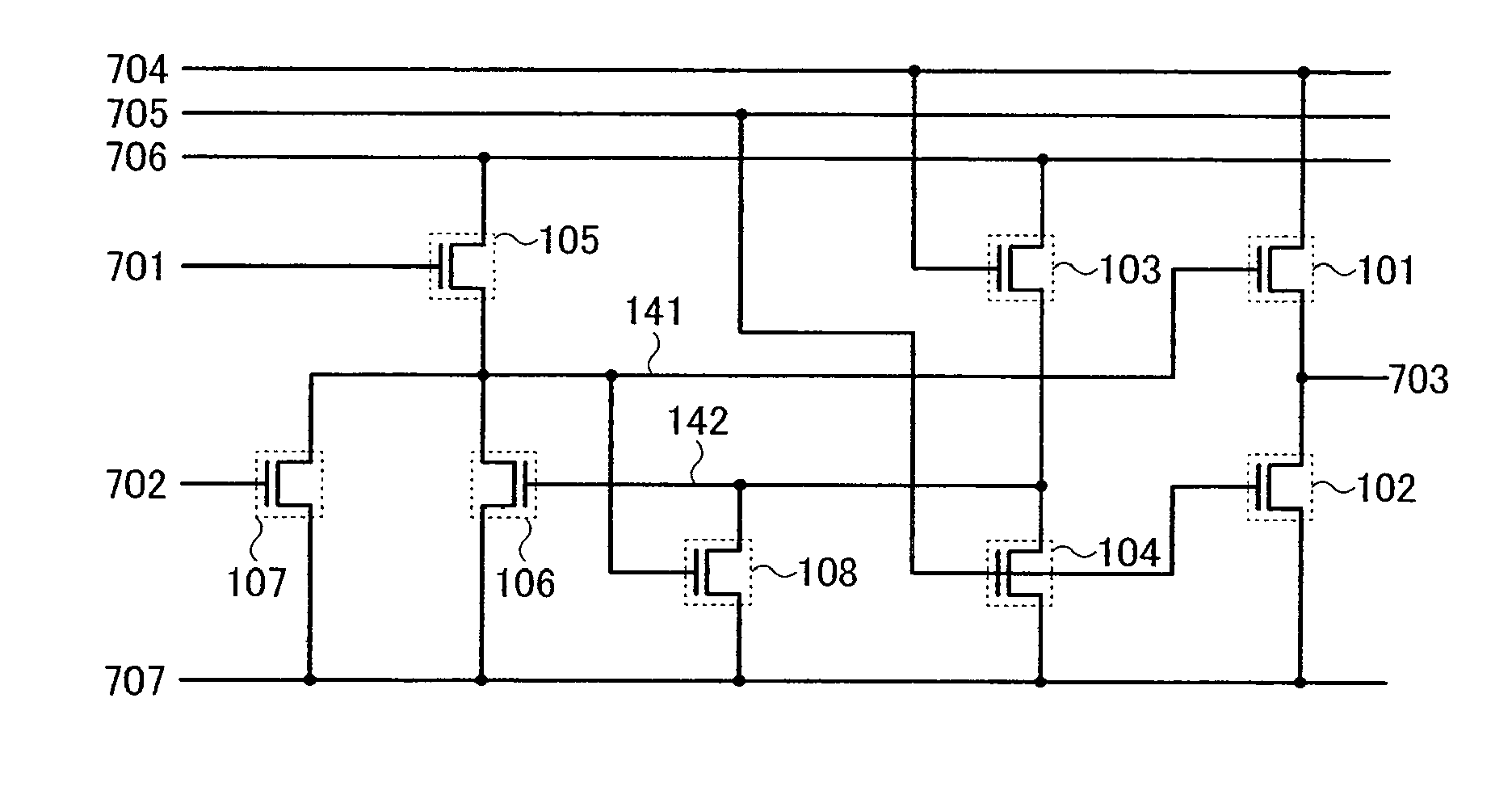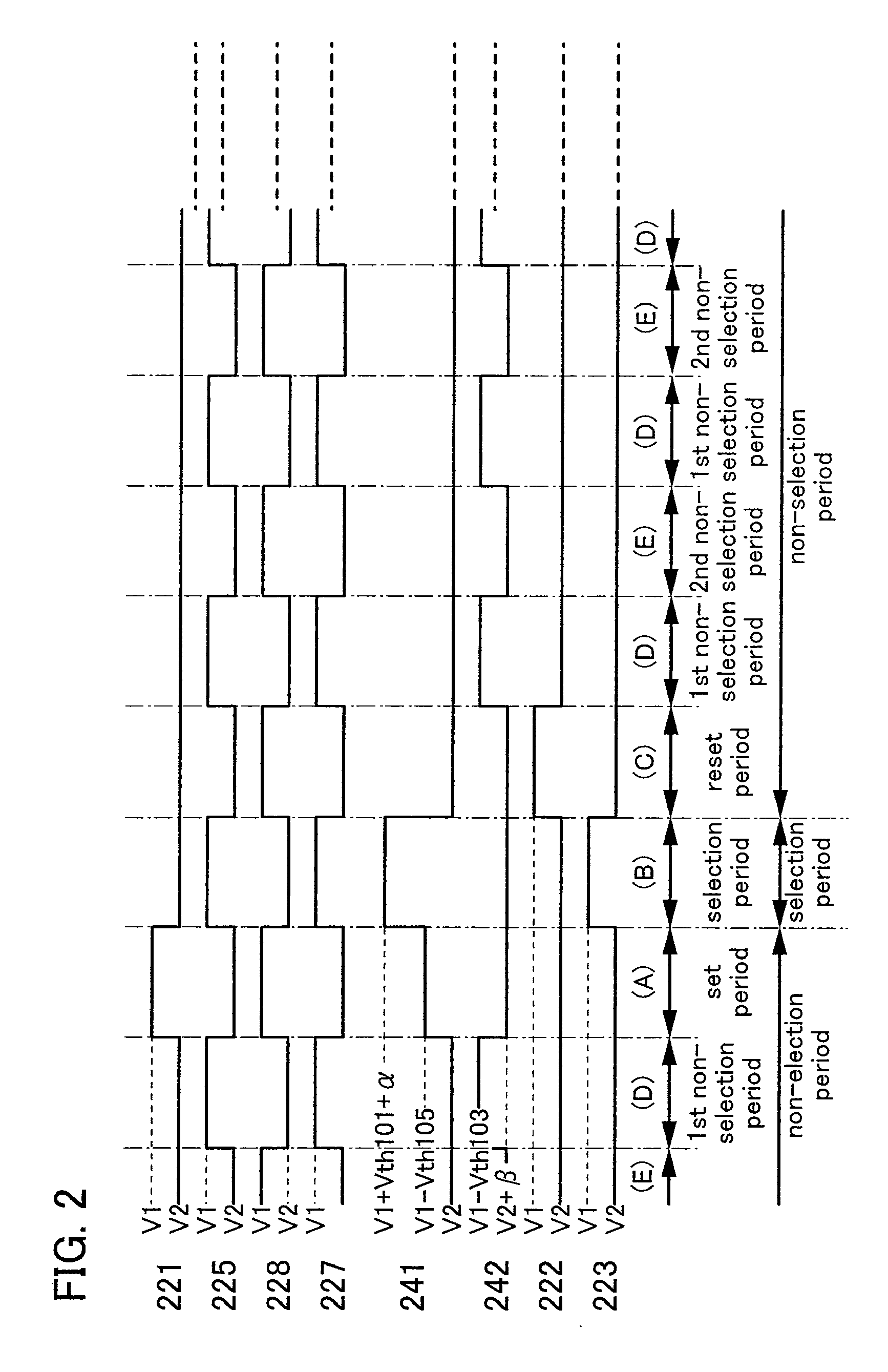Display device
a display device and display technology, applied in the field of display devices, can solve the problems of increasing the size and high definition of the display device, and the power consumption of the display device can be reduced, and achieve the effect of suppressing the characteristic deterioration of all transistors included in the shift register
- Summary
- Abstract
- Description
- Claims
- Application Information
AI Technical Summary
Benefits of technology
Problems solved by technology
Method used
Image
Examples
embodiment mode 1
[0182]In this embodiment mode, structures and driving methods of a flip-flop, a driver circuit including the flip-flop, and a display device including the driver circuit are described.
[0183]A basic structure of a flip-flop of this embodiment mode is described with reference to FIG. 1A. A flip-flop shown in FIG. 1A includes a first transistor 101, a second transistor 102, a third transistor 103, a fourth transistor 104, a fifth transistor 105, a sixth transistor 106, a seventh transistor 107, and an eighth transistor 108. In this embodiment mode, each of the first transistor 101, the second transistor 102, the third transistor 103, the fourth transistor 104, the fifth transistor 105, the sixth transistor 106, the seventh transistor 107, and the eighth transistor 108 is an N-channel transistor and is turned on when gate-source voltage (Vgs) exceeds the threshold voltage (Vth).
[0184]Note that in the flip-flop of this embodiment mode, the first transistor 101, the second transistor 102,...
embodiment mode 2
[0280]In this embodiment mode, structures and driving methods of a flip-flop which is different from those of Embodiment Mode 1, a driver circuit including the flip-flop, and a display device including the driver circuit are described. Note that portions which are similar to those of Embodiment Mode 1 are denoted by common reference numerals and detailed description of the portions which are the same and portions which have similar functions is omitted.
[0281]As a structure of the flip-flop of this embodiment mode, a structure which is similar to that of the flip-flop of Embodiment Mode 1 can be used. Note that drive timing of the flip-flop is different from that of Embodiment Mode 1. Thus, in this embodiment mode, description of the structure of the flip-flop is omitted.
[0282]Note that although the case is described in which the drive timing of this embodiment mode is applied to the flip-flop in FIG. 1A, the drive timing of this embodiment mode can be freely combined with each of th...
embodiment mode 3
[0310]In this embodiment mode, structures and driving methods of a flip-flop which is different from those of Embodiment Modes 1 and 2, a driver circuit including the flip-flop, and a display device including the driver circuit are described. In the flip-flop of this embodiment mode, an output signal of the flip-flop and a transfer signal of the flip-flop are output from different wirings by different transistors. Note that portions which are similar to those of Embodiment Modes 1 and 2 are denoted by common reference numerals and detailed description of the portions which are the same and portions which have similar functions is omitted.
[0311]A basic structure of the flip-flop of this embodiment mode is described with reference to FIG. 40. A flip-flop shown in FIG. 40 is similar to the flip-flop in FIG. 1A to which a ninth transistor 109 and a tenth transistor 110 are added.
[0312]Connection relations of the flip-flop in FIG. 40 are described. A first electrode of the ninth transist...
PUM
 Login to View More
Login to View More Abstract
Description
Claims
Application Information
 Login to View More
Login to View More - R&D
- Intellectual Property
- Life Sciences
- Materials
- Tech Scout
- Unparalleled Data Quality
- Higher Quality Content
- 60% Fewer Hallucinations
Browse by: Latest US Patents, China's latest patents, Technical Efficacy Thesaurus, Application Domain, Technology Topic, Popular Technical Reports.
© 2025 PatSnap. All rights reserved.Legal|Privacy policy|Modern Slavery Act Transparency Statement|Sitemap|About US| Contact US: help@patsnap.com



